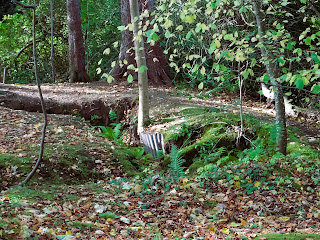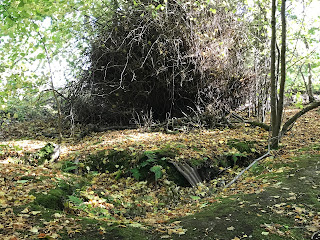On
a day of damp and drizzle, with occasional bursts of warm sunshine that
promised much but gave little, I went on a trip to Dreghorn. This is a part of Edinburgh I’ve never really
ventured to before. I think I’ve passed
through it on the bus a few times, but it is not a place I’ve ever stopped off
in. However, I’d been told there was a
rather interesting relic from the First World War in the woods here, so I
thought I’d go and take a look.
Dreghorn
Woods are next to the army barracks, so there is a lot of fencing and barbed
wire along the paths taking you round. The woods are quite tranquil though, a
haven from the busy roads nearby. Being
Autumn, the paths were pretty much mud and puddles with a covering of gold and
red from the fallen leaves. But, hey, that’s nothing for an intrepid explorer
like me!
I
took the long walk round to my destination, which lay on a slope by the river
and just down from the barracks. Handily
signposted, otherwise you’d just think it was some mud and old earthworks, were
what I’d come looking for. These holes
in the ground were actually training trenches from World War One, to get the
poor sods drafted into the army ready for fighting out on the front.
I
followed a well-worn path that skirted around them. A path of wet, slippery mud and leaf
goo. It gave some impression of what the
soldiers training here would have had to go through. Though, unlike them, I wasn’t going to crawl
through the trenches and the puddles of water and sludge.
Dreghorn
Woods used to form part of the Dreghorn Estate, which stretched up into the
nearby Pentland Hills. In 1905 the
estate was purchased by the War Department, now the Ministry of Defence, for
training, and as a barracks. During
World War One, recruits constructed
a major trench system through the woods and were trained in the tactics and
ways of trench warfare. Though, having
read both Erich Maria Remarque’s
‘All Quiet on the Western Front’ and Ernst Jünger's ‘Storm of Steel’ I do
wonder how well it would have really prepared them for the slaughter they were
about to face.
After
World War Two, the military stopped using the woods for training and the
trenches became overgrown and many were eroded away. They were largely forgotten about until a
local historian, Lynne Gladstone-Millar, led a campaign to preserve them. Her father, who fought in the First World War,
had trained at Dreghorn Woods, and had told her about his experiences there and
that the mud in the woods, the ‘Dreghorn Sludge’, had been good training for
fighting at the Somme. In 2013 an archaeological
survey was carried out on the remnants of the trench system, and it was cleared
of trees and vegetation to help preserve it.
After taking a walk around, I left the Skulferatu that had accompanied me, at the side of one of the shallower trenches, by the remains of some corrugated iron that would once have been used to strengthen the sides of the trench.
The
coordinates for the location of the Skulferatu are –
Latitude
55.902423
Longitude
-3.24401
what3words:
book.trains.lock
I
used the following sources for information on the Training Trenches –
Information Board at Site
Historic Environment Scotland
Dreghorn Woods Training
Trenches
BBC – World War One at Home
BBC - World War One At Home, Edinburgh,
Scotland - The Dreghorn Training Trenches






























